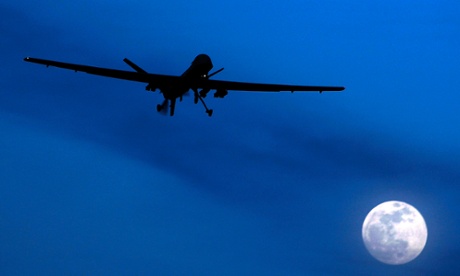|
By Jon Swaine
From The Guardian | Original Article
Experts urge White House to explain basis for potential assassination against al-Qaida-linked suspect targeted abroad
US considers drone strike on US al-Qaida suspect abroad

The Pentagon may only operate in established conflict zones, a definition that extends to the Pakistan-Afghanistan border. Photograph: Kirsty Wigglesworth /AP
The Obama administration came under renewed pressure to disclose the legal grounds for its drone programme on Monday, amid reports that another US citizen accused of plotting attacks against Americans for al-Qaida overseas is to be assassinated.
Legal experts and civil liberties campaigners urged the White House to explain the basis for a potential strike against the suspect, alleged to be an active “facilitator” for the terrorist network and already responsible for deadly attacks on Americans.
Senior US officials were reported by the Associated Press to be weighing the benefits of killing the man against the likelihood of international condemnation and domestic criticism for targeting an American who has not been not charged with a crime. The Washington Post said it had confirmed the story.
Hina Shamsi, the director of the American Civil Liberties Union’s (ACLU) National Security Project, said the Obama administration “continues to fight against even basic transparency” about how it justifies the executions of thousands of people under the programme.
“The targeted killing of an American being considered right now shows the inherent danger of a killing programme based on vague and shifting legal standards, which has made it disturbingly easy for the government to operate outside the law,” she said.
Citing several US officials, the AP reported that the man was accused of planning further strikes with improvised explosive devices. He was reported to be hiding, well guarded, in a remote part of a state unwilling to allow US operations on its soil and “unable to go after him”, prompting speculation that a strike would mean the drone programme being extended into a new country, such as Libya.
One official said that the Pentagon did ultimately decide to recommend lethal action, according to the report.
His case is apparently the first test for a new guideline, outlined by President Obama in May last year following sharp criticism of the secrecy cloaking the drone programme, on the checks needed for the targeting of an American citizen.
“The Department of Justice will conduct an additional legal analysis to ensure that such action may be conducted against the individual consistent with the constitution and laws of the United States,” a White House policy note said at the time.
The case was apparently alluded to last week by Mike Rogers, the chairman of the House of Representatives intelligence committee, who complained that Obama’s “self-imposed red tape” limiting drone strikes had placed a number of suspects out of reach and “placed Americans’ lives at risk”.

Representative Mike Rogers has criticised regulation of the US drone programme. Photograph: AP
Justice Department officials have reportedly not yet built a formal case against the man defining him as an “enemy combatant” under the resolution authorising military force against al-Qaida, passed by Congress after the September 11 attacks.
The president also insisted that his administration would only ever launch a drone strike against any suspect to stop a planned attack, when it was not possible to capture a suspect, and when there was “near certainty” that civilians would not be injured or killed.
He declined, however, to outline the administration’s explicit legal basis for its assassination policy, and Justice Department memos doing so have only been shared with select congressmen. The ACLU and media organisations are currently suing the US government for public access to the documents.
“Once again we are all left guessing,” Sarah Knuckey, an international human rights lawyer and an adviser to the UN special rapporteur on extrajudicial executions, told the Guardian. “We can not have an informed public debate. We do not have effective oversight.”
Calling for a new system of “serious and meaningful democratic accountability”, Knuckey said: “We are taking people’s lives, and my view is that this could be quite lawful and appropriate, in some circumstances, for self-defence. But what are we doing, and on what basis? We don’t know.”
Officials were also said to be debating how a strike against the suspect could be authorised under the guidelines announced by Obama last year.
In its policy note, the White House stressed that the US “respects national sovereignty and international law” yet also threatened action against suspects when “authorities in the country where action is contemplated cannot or will not effectively address the threat” posed to Americans.
The AP also reported that under new internal rules shifting responsibility for drones to the Pentagon, “American suspected terrorists overseas can only be killed by the military, not the CIA,” which previously carried out a large number of the deadly strikes. Yet the Pentagon may only operate in established conflict zones, a definition that extends to the Pakistan-Afghanistan border.
If assassinated, the man would become the fifth American known to have been killed by US drones since Obama came to office in 2009. Anwar al-Awlaki, a radical preacher alleged to have been plotting to attack Americans, was killed in Yemen in September 2011 along with Samir Khan, a Pakistani-American who published Inspire, al-Qaeda’s English-language magazine.
Two weeks later, Awlaki’s 16-year-old son, Abdulrahman, was killed by another US strike in Yemen. Jude Kenan Mohammad, alleged to have at one stage been part of an eight-man terror cell in North Carolina, was killed by a US drone strike in Pakistan later in 2011.
The White House, the Justice Department and the Defense Department declined to comment.
|